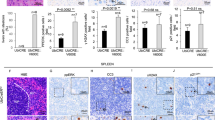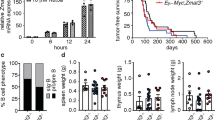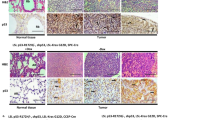Abstract
Lung cancer arises through the acquisition of a number of genetic lesions, with a preponderance of activating mutations in the canonical mitogen-activated protein kinase (MAPK) cascade (RTK-RAS-RAF-MEK). BrafV600E expression induces benign lung adenomas that fail to progress to adenocarcinoma because of oncogene-induced senescence (OIS). BrafV600E expression, coupled with simultaneous p53 ablation, permits bypass of senescence and progression to lung adenocarcinoma. However, spontaneous human tumors sustain mutations in a temporally separated manner. Here, we use a mouse lung cancer model where oncogene activation (BrafV600E expression) and tumor suppressor loss (p53 ablation) are independently controlled through the actions of Flp and Cre recombinase, respectively. We show that p53 loss before OIS is permissive for the transition from lung adenoma to adenocarcinoma. In contrast, p53 loss after senescence is established fails to enable escape from senescence and disease progression. This study demonstrates that BrafV600E induced senescence is irreversible in vivo and suggests that therapy-induced senescence would halt further tumor progression.
This is a preview of subscription content, access via your institution
Access options
Subscribe to this journal
Receive 50 print issues and online access
$259.00 per year
only $5.18 per issue
Buy this article
- Purchase on Springer Link
- Instant access to full article PDF
Prices may be subject to local taxes which are calculated during checkout





Similar content being viewed by others
References
Herbst RS, Heymach JV, Lippman SM . Lung cancer. N Engl J Med 2008; 359: 1367–1380.
Ding L, Getz G, Wheeler DA, Mardis ER, McLellan MD, Cibulskis K et al. Somatic mutations affect key pathways in lung adenocarcinoma. Nature 2008; 455: 1069–1075.
Cancer Genome Atlas Research N. Comprehensive molecular profiling of lung adenocarcinoma. Nature 2014; 511: 543–550.
Imielinski M, Berger AH, Hammerman PS, Hernandez B, Pugh TJ, Hodis E et al. Mapping the hallmarks of lung adenocarcinoma with massively parallel sequencing. Cell 2012; 150: 1107–1120.
Devarakonda S, Morgensztern D, Govindan R . Genomic alterations in lung adenocarcinoma. Lancet Oncol 2015; 16: e342–e351.
Lemjabbar-Alaoui H, Hassan OU, Yang YW, Buchanan P . Lung cancer: biology and treatment options. Biochim Biophys Acta 2015; 1856: 189–210.
Vicent S, Lopez-Picazo JM, Toledo G, Lozano MD, Torre W, Garcia-Corchon C et al. ERK1/2 is activated in non-small-cell lung cancer and associated with advanced tumours. Br J Cancer 2004; 90: 1047–1052.
Wistuba II, Gazdar AF . Lung cancer preneoplasia. Annu Rev Pathol 2006; 1: 331–348.
Shigematsu H, Gazdar AF . Somatic mutations of epidermal growth factor receptor signaling pathway in lung cancers. Int J Cancer 2006; 118: 257–262.
Kim ES . Chemotherapy resistance in lung cancer. Adv Exp Med Biol 2016; 893: 189–209.
Bamford S, Dawson E, Forbes S, Clements J, Pettett R, Dogan A et al. The COSMIC (Catalogue of Somatic Mutations in Cancer) database and website. Br J Cancer 2004; 91: 355–358.
Wan PT, Garnett MJ, Roe SM, Lee S, Niculescu-Duvaz D, Good VM et al. Mechanism of activation of the RAF-ERK signaling pathway by oncogenic mutations of B-RAF. Cell 2004; 116: 855–867.
Kandoth C, McLellan MD, Vandin F, Ye K, Niu B, Lu C et al. Mutational landscape and significance across 12 major cancer types. Nature 2013; 502: 333–339.
Eroglu Z, Ribas A . Combination therapy with BRAF and MEK inhibitors for melanoma: latest evidence and place in therapy. Ther Adv Med Oncol 2016; 8: 48–56.
Paik PK, Arcila ME, Fara M, Sima CS, Miller VA, Kris MG et al. Clinical characteristics of patients with lung adenocarcinomas harboring BRAF mutations. J Clin Oncol 2011; 29: 2046–2051.
Planchard D, Kim TM, Mazieres J, Quoix E, Riely G, Barlesi F et al. Dabrafenib in patients with BRAF(V600E)-positive advanced non-small-cell lung cancer: a single-arm, multicentre, open-label, phase 2 trial. Lancet Oncol 2016; 17: 642–650.
Manzano JL, Layos L, Buges C, de Los Llanos Gil M, Vila L, Martinez-Balibrea E et al. Resistant mechanisms to BRAF inhibitors in melanoma. Ann Transl Med 2016; 4: 237.
Turski ML, Vidwans SJ, Janku F, Garrido-Laguna I, Munoz J, Schwab R et al. Genomically driven tumors and actionability across histologies: BRAF-mutant cancers as a paradigm. Mol Cancer Ther 2016; 15: 533–547.
Welsh SJ, Rizos H, Scolyer RA, Long GV . Resistance to combination BRAF and MEK inhibition in metastatic melanoma: Where to next? Eur J Cancer 2016; 62: 76–85.
Dankort D, Filenova E, Collado M, Serrano M, Jones K, McMahon M . A new mouse model to explore the initiation, progression, and therapy of BRAFV600E-induced lung tumors. Genes Dev 2007; 21: 379–384.
Johnson L, Mercer K, Greenbaum D, Bronson RT, Crowley D, Tuveson DA et al. Somatic activation of the K-ras oncogene causes early onset lung cancer in mice. Nature 2001; 410: 1111–1116.
Jackson EL, Willis N, Mercer K, Bronson RT, Crowley D, Montoya R et al. Analysis of lung tumor initiation and progression using conditional expression of oncogenic K-ras. Genes Dev 2001; 15: 3243–3248.
Guerra C, Mijimolle N, Dhawahir A, Dubus P, Barradas M, Serrano M et al. Tumor induction by an endogenous K-ras oncogene is highly dependent on cellular context. Cancer Cell 2003; 4: 111–120.
Kramer BW, Gotz R, Rapp UR . Use of mitogenic cascade blockers for treatment of C-Raf induced lung adenoma in vivo: CI-1040 strongly reduces growth and improves lung structure. BMC Cancer 2004; 4: 24.
Trejo CL, Juan J, Vicent S, Sweet-Cordero A, McMahon M . MEK1/2 inhibition elicits regression of autochthonous lung tumors induced by KRASG12D or BRAFV600E. Cancer Res 2012; 72: 3048–3059.
Serrano M, Lin AW, McCurrach ME, Beach D, Lowe SW . Oncogenic ras provokes premature cell senescence associated with accumulation of p53 and p16INK4a. Cell 1997; 88: 593–602.
Lin AW, Barradas M, Stone JC, van Aelst L, Serrano M, Lowe SW . Premature senescence involving p53 and p16 is activated in response to constitutive MEK/MAPK mitogenic signaling. Genes Dev 1998; 12: 3008–3019.
Zhu J, Woods D, McMahon M, Bishop JM . Senescence of human fibroblasts induced by oncogenic Raf. Genes Dev 1998; 12: 2997–3007.
Kuilman T, Michaloglou C, Mooi WJ, Peeper DS . The essence of senescence. Genes Dev 2010; 24: 2463–2479.
Larsson LG . Oncogene- and tumor suppressor gene-mediated suppression of cellular senescence. Semin Cancer Biol 2011; 21: 367–376.
Chakradeo S, Elmore LW, Gewirtz DA . Is senescence reversible? Curr Drug Targets 2016; 17: 460–466.
Dankort D, Curley DP, Cartlidge RA, Nelson B, Karnezis AN, Damsky WE Jr et al. Braf(V600E) cooperates with Pten loss to induce metastatic melanoma. Nat Genet 2009; 41: 544–552.
Dhomen N, Reis-Filho JS, da Rocha Dias S, Hayward R, Savage K, Delmas V et al. Oncogenic Braf induces melanocyte senescence and melanoma in mice. Cancer Cell 2009; 15: 294–303.
Vredeveld LC, Possik PA, Smit MA, Meissl K, Michaloglou C, Horlings HM et al. Abrogation of BRAFV600E-induced senescence by PI3K pathway activation contributes to melanomagenesis. Genes Dev 2012; 26: 1055–1069.
Wang J, Kobayashi T, Floc'h N, Kinkade CW, Aytes A, Dankort D et al. B-Raf activation cooperates with PTEN loss to drive c-Myc expression in advanced prostate cancer. Cancer Res 2012; 72: 4765–4776.
Huillard E, Hashizume R, Phillips JJ, Griveau A, Ihrie RA, Aoki Y et al. Cooperative interactions of BRAFV600E kinase and CDKN2A locus deficiency in pediatric malignant astrocytoma as a basis for rational therapy. Proc Natl Acad Sci USA 2012; 109: 8710–8715.
Michaloglou C, Vredeveld LC, Soengas MS, Denoyelle C, Kuilman T, van der Horst CM et al. BRAFE600-associated senescence-like cell cycle arrest of human naevi. Nature 2005; 436: 720–724.
Tabor V, Bocci M, Alikhani N, Kuiper R, Larsson LG . MYC synergizes with activated BRAFV600E in mouse lung tumor development by suppressing senescence. Cancer Res 2014; 74: 4222–4229.
Cisowski J, Sayin VI, Liu M, Karlsson C, Bergo MO . Oncogene-induced senescence underlies the mutual exclusive nature of oncogenic KRAS and BRAF. Oncogene 2015; 35: 1328–1333.
Kinno T, Tsuta K, Shiraishi K, Mizukami T, Suzuki M, Yoshida A et al. Clinicopathological features of nonsmall cell lung carcinomas with BRAF mutations. Ann Oncol 2014; 25: 138–142.
Marchetti A, Felicioni L, Malatesta S, Grazia Sciarrotta M, Guetti L, Chella A et al. Clinical features and outcome of patients with non-small-cell lung cancer harboring BRAF mutations. J Clin Oncol 2011; 29: 3574–3579.
Lipsyc M, Yaeger R . Impact of somatic mutations on patterns of metastasis in colorectal cancer. J Gastrointest Oncol 2015; 6: 645–649.
Puzanov I, Flaherty KT . Targeted molecular therapy in melanoma. Semin Cutan Med Surg 2010; 29: 196–201.
Bivona TG, Doebele RC . A framework for understanding and targeting residual disease in oncogene-driven solid cancers. Nat Med 2016; 22: 472–478.
Planchard D, Besse B, Groen HJ, Souquet PJ, Quoix E, Baik CS et al. Dabrafenib plus trametinib in patients with previously treated BRAF(V600E)-mutant metastatic non-small cell lung cancer: an open-label, multicentre phase 2 trial. Lancet Oncol 2016; 17: 984–993.
Trejo CL, Green S, Marsh V, Collisson EA, Iezza G, Phillips WA et al. Mutationally activated PIK3CA(H1047R) cooperates with BRAF(V600E) to promote lung cancer progression. Cancer Res 2013; 73: 6448–6461.
Bennett WP . p53 alterations in progenitor lesions of the bronchus, esophagus, oral cavity, and colon. Cancer Detect Prev 1995; 19: 503–511.
Jonkers J, Meuwissen R, van der Gulden H, Peterse H, van der Valk M, Berns A . Synergistic tumor suppressor activity of BRCA2 and p53 in a conditional mouse model for breast cancer. Nat Genet 2001; 29: 418–425.
Shai A, Dankort D, Juan J, Green S, McMahon M . TP53 silencing bypasses growth arrest of BRAFV600E-induced lung tumor cells in a two-switch model of lung tumorigenesis. Cancer Res 2015; 75: 3167–3180.
Collado M, Gil J, Efeyan A, Guerra C, Schuhmacher AJ, Barradas M et al. Tumour biology: senescence in premalignant tumours. Nature 2005; 436: 642.
Hayashi S, McMahon AP . Efficient recombination in diverse tissues by a tamoxifen-inducible form of Cre: a tool for temporally regulated gene activation/inactivation in the mouse. Dev Biol 2002; 244: 305–318.
Yatabe Y, Mitsudomi T, Takahashi T . TTF-1 expression in pulmonary adenocarcinomas. Am J Surg Pathol 2002; 26: 767–773.
Hogan BL, Barkauskas CE, Chapman HA, Epstein JA, Jain R, Hsia CC et al. Repair and regeneration of the respiratory system: complexity, plasticity, and mechanisms of lung stem cell function. Cell Stem Cell 2014; 15: 123–138.
Nikitin AY, Alcaraz A, Anver MR, Bronson RT, Cardiff RD, Dixon D et al. Classification of proliferative pulmonary lesions of the mouse: recommendations of the mouse models of human cancers consortium. Cancer Res 2004; 64: 2307–2316.
Acosta JC, Banito A, Wuestefeld T, Georgilis A, Janich P, Morton JP et al. A complex secretory program orchestrated by the inflammasome controls paracrine senescence. Nat Cell Biol 2013; 15: 978–990.
Kuilman T, Michaloglou C, Vredeveld LC, Douma S, van Doorn R, Desmet CJ et al. Oncogene-induced senescence relayed by an interleukin-dependent inflammatory network. Cell 2008; 133: 1019–1031.
Sharpless NE, Sherr CJ . Forging a signature of in vivo senescence. Nat Rev Cancer 2015; 15: 397–408.
Coppe JP, Desprez PY, Krtolica A, Campisi J . The senescence-associated secretory phenotype: the dark side of tumor suppression. Annu Rev Pathol 2010; 5: 99–118.
Junttila MR, Karnezis AN, Garcia D, Madriles F, Kortlever RM, Rostker F et al. Selective activation of p53-mediated tumour suppression in high-grade tumours. Nature 2010; 468: 567–571.
Feldser DM, Kostova KK, Winslow MM, Taylor SE, Cashman C, Whittaker CA et al. Stage-specific sensitivity to p53 restoration during lung cancer progression. Nature 2010; 468: 572–575.
Kubbutat MH, Jones SN, Vousden KH . Regulation of p53 stability by Mdm2. Nature 1997; 387: 299–303.
Weber JD, Taylor LJ, Roussel MF, Sherr CJ, Bar-Sagi D . Nucleolar Arf sequesters Mdm2 and activates p53. Nat Cell Biol 1999; 1: 20–26.
Baek KH, Bhang D, Zaslavsky A, Wang LC, Vachani A, Kim CF et al. Thrombospondin-1 mediates oncogenic Ras-induced senescence in premalignant lung tumors. J Clin Invest 2013; 123: 4375–4389.
Noguchi M . Stepwise progression of pulmonary adenocarcinoma—clinical and molecular implications. Cancer Metastasis Rev 2010; 29: 15–21.
Jones S, Chen WD, Parmigiani G, Diehl F, Beerenwinkel N, Antal T et al. Comparative lesion sequencing provides insights into tumor evolution. Proc Natl Acad Sci USA 2008; 105: 4283–4288.
Vogelstein B, Papadopoulos N, Velculescu VE, Zhou S, Diaz Jr LA, Kinzler KW . Cancer genome landscapes. Science 2013; 339: 1546–1558.
Muzumdar MD, Dorans KJ, Chung KM, Robbins R, Tammela T, Gocheva V et al. Clonal dynamics following p53 loss of heterozygosity in Kras-driven cancers. Nat Commun 2016; 7: 12685.
Stott FJ, Bates S, James MC, McConnell BB, Starborg M, Brookes S et al. The alternative product from the human CDKN2A locus, p14(ARF), participates in a regulatory feedback loop with p53 and MDM2. EMBO J 1998; 17: 5001–5014.
Inoue K, Roussel MF, Sherr CJ . Induction of ARF tumor suppressor gene expression and cell cycle arrest by transcription factor DMP1. Proc Natl Acad Sci USA 1999; 96: 3993–3998.
Mallakin A, Sugiyama T, Taneja P, Matise LA, Frazier DP, Choudhary M et al. Mutually exclusive inactivation of DMP1 and ARF/p53 in lung cancer. Cancer Cell 2007; 12: 381–394.
Ameyar-Zazoua M, Wisniewska MB, Bakiri L, Wagner EF, Yaniv M, Weitzman JB . AP-1 dimers regulate transcription of the p14/p19ARF tumor suppressor gene. Oncogene 2005; 24: 2298–2306.
Pencik J, Schlederer M, Gruber W, Unger C, Walker SM, Chalaris A et al. STAT3 regulated ARF expression suppresses prostate cancer metastasis. Nat Commun 2015; 6: 7736.
Ko A, Han SY, Song J . Dynamics of ARF regulation that control senescence and cancer. BMB Rep 2016; 49: 598–606.
Lee YS, Lee JW, Jang JW, Chi XZ, Kim JH, Li YH et al. Runx3 inactivation is a crucial early event in the development of lung adenocarcinoma. Cancer Cell 2013; 24: 603–616.
Jacobs JJ, Kieboom K, Marino S, DePinho RA, van Lohuizen M . The oncogene and polycomb-group gene bmi-1 regulates cell proliferation and senescence through the ink4a locus. Nature 1999; 397: 164–168.
Young NP, Jacks T . Tissue-specific p19Arf regulation dictates the response to oncogenic K-ras. Proc Natl Acad Sci USA 2010; 107: 10184–10189.
Volanakis EJ, Williams RT, Sherr CJ . Stage-specific Arf tumor suppression in Notch1-induced T-cell acute lymphoblastic leukemia. Blood 2009; 114: 4451–4459.
Sherr CJ . Divorcing ARF and p53: an unsettled case. Nat Rev Cancer 2006; 6: 663–673.
Bieging-Rolett KT, Johnson TM, Brady CA, Beaudry VG, Pathak N, Han S et al. p19 is required for the cellular response to chronic DNA damage. Oncogene 2016; 35: 4414–4421.
Khoo KH, Verma CS, Lane DP . Drugging the p53 pathway: understanding the route to clinical efficacy. Nat Rev Drug Discov 2014; 13: 217–236.
Soriano P . Generalized lacZ expression with the ROSA26 Cre reporter strain. Nat Genet 1999; 21: 70–71.
Truett GE, Heeger P, Mynatt RL, Truett AA, Walker JA, Warman ML . Preparation of PCR-quality mouse genomic DNA with hot sodium hydroxide and tris (HotSHOT). Biotechniques 2000; 29: 4.
Fasbender A, Lee JH, Walters RW, Moninger TO, Zabner J, Welsh MJ . Incorporation of adenovirus in calcium phosphate precipitates enhances gene transfer to airway epithelia in vitro and in vivo. J Clin Invest 1998; 102: 184–193.
Jackson EL, Olive KP, Tuveson DA, Bronson R, Crowley D, Brown M et al. The differential effects of mutant p53 alleles on advanced murine lung cancer. Cancer Res 2005; 65: 10280–10288.
Charan J, Kantharia ND . How to calculate sample size in animal studies? J Pharmacol Pharmacother 2013; 4: 303–306.
Faul F, Erdfelder E, Lang AG, Buchner A . G*Power 3: a flexible statistical power analysis program for the social, behavioral, and biomedical sciences. Behav Res Methods 2007; 39: 175–191.
Acknowledgements
DD would like to thank Martin McMahon for his generosity and guidance, which enabled this work. We thank members of the Dankort lab for discussions, Eve Bigras for administrative assistance, Drs Siegfried Hekimi, Alain Nepveu and Peter M Siegel for critical comments. We thank the lab of Dr Hoang Trang for providing necessary reagents. These studies were supported by grants from the Canadian Institutes of Health Research (CIHR, MOP-97925), Canadian Cancer Society Research Initiative (no. 704228) and Cancer Research Society (no. 19087).
Author information
Authors and Affiliations
Corresponding author
Ethics declarations
Competing interests
The authors declare no conflict of interest.
Additional information
Supplementary Information accompanies this paper on the Oncogene website
Rights and permissions
About this article
Cite this article
Garnett, S., Dutchak, K., McDonough, R. et al. p53 loss does not permit escape from BrafV600E-induced senescence in a mouse model of lung cancer. Oncogene 36, 6325–6335 (2017). https://doi.org/10.1038/onc.2017.235
Received:
Revised:
Accepted:
Published:
Issue Date:
DOI: https://doi.org/10.1038/onc.2017.235



